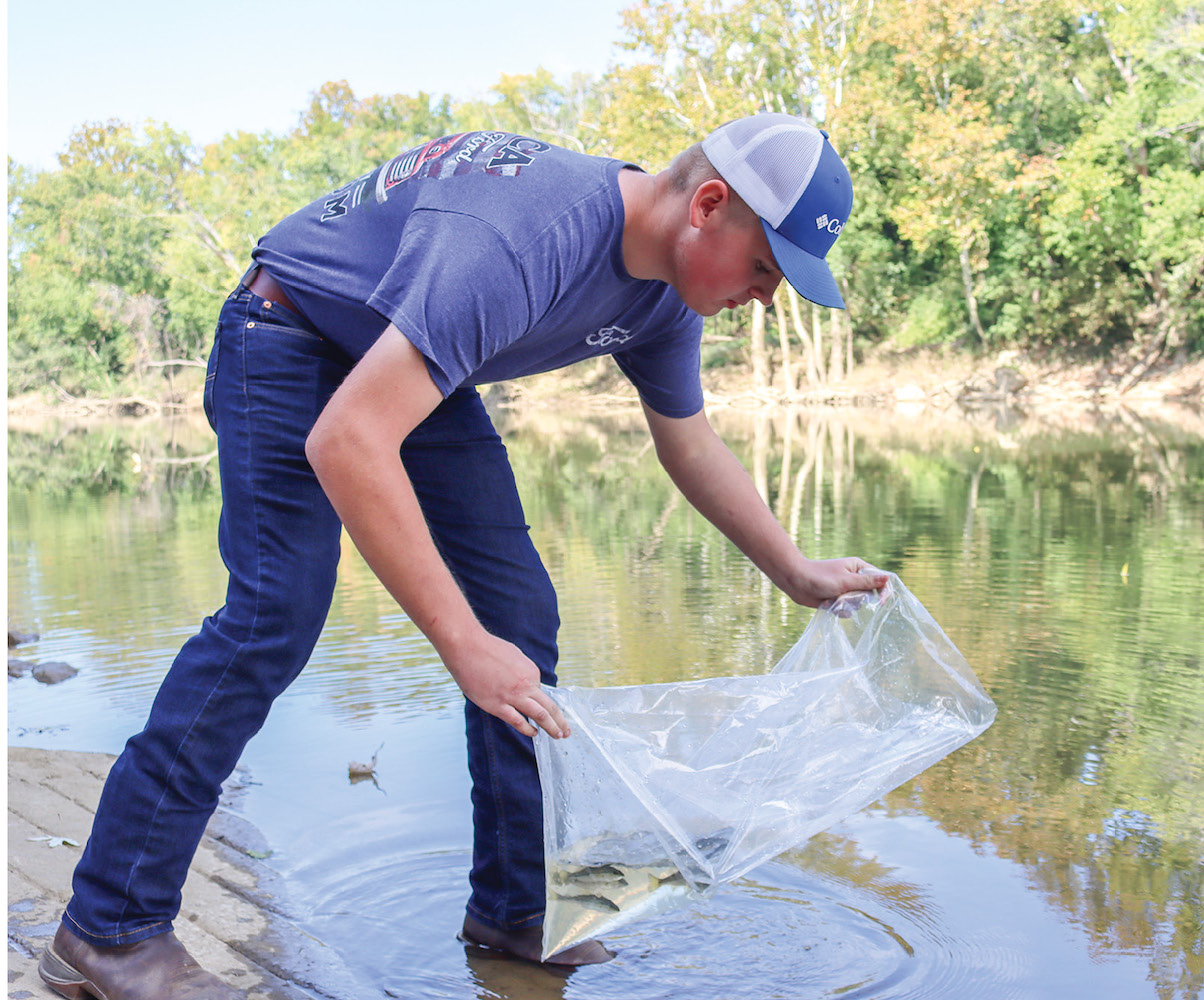
The Kentucky and Ohio River bass fisheries received a boost in the fall, as the Kentucky Department of Fish and Wildlife Resources (KDFWR) paired with students, bass club members and National Guardsmen to stock largemouth bass.
A $25,000 grant from B.A.S.S. sponsor AFTCO helped finance the project.
“We’re like many other states in that we receive no general-fund dollars,” said Dave Dreves, KDFWR’s fisheries chief. “We depend on license sales and federal dollars generated through license sales [by the Wallop-Breaux Sport Fish Restoration Act].
“So, that AFTCO donation provided some very welcome assistance.”
Dreves was made aware of AFTCO’s broad commitment to conservation when he attended the Conservation Summit that was held in conjunction with the 2022 Academy Sports + Outdoors Bassmaster Classic. AFTCO Chairman and CEO Bill Shedd offered to help after the fisheries chief explained Kentucky’s need to periodically stock those river fisheries to sustain them. “And we’re very grateful,” Dreves added.
Through periodic sampling, the agency tracks population swings and then intervenes when it deems it necessary and can afford to, stocking from two hatcheries. “We are not looking to increase the numbers of bass but to smooth out the year classes,” Dreves said.
“We want to fill the gaps in reproduction, to keep a balance.”
Proactive management is especially necessary for Ohio and Kentucky river fisheries because of siltation and loss of habitat from dams and channelization for commercial navigation.
“Our research in the Ohio River shows that if we weren’t stocking, there would be many fewer fish,” the fisheries chief said. “The habitat is just not there for successful recruitment. We tried artificial spawning structures, but they just got covered up too quickly with silt.
“And we learned that the contribution of marked [stocked] fish can be high.”
B.A.S.S. National Conservation Director Gene Gilliland echoed that sentiment. “Without these stockings, the fisheries would be almost nonexistent,” he said.
Gilliland pointed out that consistent low weights and numbers from tournaments on the Ohio River confirm the ongoing need for supplemental stocking in such special circumstances.
Management of bass populations in Ohio River pools is complicated even more by boom-and-bust cycles for shad, Dreves added. “With a bumper crop of shad, you might see bass grow to 10 to 12 inches in a year.”
But usually bass require three to four years to reach 14 inches, which is fairly common across the country, the fisheries chief said.
With winter and spring sampling revealing the need for supplemental stockings in 2022, KDFWR used the AFTCO donation to assist in spawning 300,000 largemouth bass. About 215,000 were raised to 2 inches and released in early summer, while 70,000 were grown to 5 inches and stocked in the fall. The remainder were kept to feed and grow and probably be stocked in eastern Kentucky next year.
Additionally, the agency raised and stocked 81,000 2-inch smallmouth bass at Laurel River Lake to address angler concerns about its decline in productivity. If all goes as planned, two more stockings will follow “to see what happens.”
On the Ohio River, at a rate of 100 fish per acre as a goal, 2-inch largemouth were released in pool embayments. Field staff stocked 75,000 in Markland, 25,000 in Meldahl, 9,000 in Cannelton and 7,000 in McAlpine.
The agency also stocked 2-inchers in two upper pools and middle stretches of the Kentucky River.
The upper reaches have more structure, while “there’s not a lot of backwater habitat and an even greater boom and bust on shad and bass recruitment [in the middle],” Dreves explained.
KDFWR biologists were assisted by 45 Future Farmers of America students from Madison and Estill counties, as well as State Rep. Bill Wesley and volunteers from the River Rats Bass Club and the National Guard.
Dreves said Wesley asked the agency about the possibility of stocking bass in the Kentucky River. The AFTCO donation helped make that possible, and 64,000 of the 2-inchers were stocked there in June.
But severe flooding followed, and so KDFWR decided to follow up with the fall stocking of 1,600 5-inch fish.
Traditionally, raising bass to 5 inches in hatcheries was an expensive proposition, as they were fed live forage. But Kentucky biologist Josh Pennington explained that managers have discovered that by keeping fish in the ponds on a zooplankton diet, “We’re saving a lot of money avoiding minnow forage.”
Still, without that $25,000 donation from AFTCO, Dreves said his agency “would have had to cut out something, maybe habitat work,” if it wanted to stock as many bass as it did in 2022.
“We’re really grateful for AFTCO’s assistance and willing to take it as often as they will give,” he said.
Of its efforts, AFTCO said, “Freshwater conservation needs are often highly regionalized and best driven forward at the grass-roots level. Our local efforts are focused on supporting state agencies and regional projects through our bass fishing conservation grant programs.
“Nationally, in addition to funding annual B.A.S.S. Nation conservation grants, AFTCO supports the creation of artificial and natural habitats, lake cleanups, the Bass Bus Live Release Boat and [offers] our Fish Care 101 education content.”
